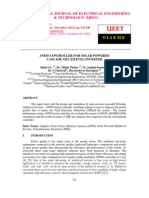Signal Summary
Signal Summary
Uploaded by
aryaman58Copyright:
Available Formats
Signal Summary
Signal Summary
Uploaded by
aryaman58Original Description:
Copyright
Available Formats
Share this document
Did you find this document useful?
Is this content inappropriate?
Copyright:
Available Formats
Signal Summary
Signal Summary
Uploaded by
aryaman58Copyright:
Available Formats
Time Reversal
Time Scaling
Time Reversal
Only the case a > 1, where a is an integer, makes sense, as x[n] is undefined for fractional values of n. In this case, called decimation or downsampling, we not only get a time compression of the signal, but the signal can also lose part of its information; That is, some of its values may disappear in the resulting signal y[n].
EXPONENTIAL SIGNALS
The complex exponential signal:
This means that the output of an LTI system subjected to an exponential input signal will also be an exponential with the same exponent, but in general with a different real or complex amplitude.
Real Exponential Signals
1. Continuous Time
2. Discrete Time
Complex Exponential Signals
1. Continuous Time
Using Eulers relation, we obtain the signal in rectangular form:
2.
Discrete Time
Using Eulers relation, we get the rectangular form of the discrete-time complex exponential:
Clearly, the magnitude r of a determines whether the envelope of x[n] grows, decreases, or remains constant with time.
PERIODIC COMPLEX EXPONENTIAL AND SINUSOIDAL SIGNALS In our study of complex exponential signals so far, we have found that in the cases in continuous time and in discrete time, we obtain signals whose trajectories lie on the unit circle in the complex plane. In particular, their real and imaginary parts are sinusoidal signals. We will see that in the continuous-time case, these signals are always periodic, but that is not necessarily the case in discrete time. Periodic complex exponentials can be used to define sets of harmonically related exponentials that have special properties that will be used later on to define the Fourier series.
Continuous Time
In continuous time, complex exponential and sinusoidal signals of constant amplitude are all periodic. Periodic Complex Exponentials Consider the complex exponential signal periodic with fundamental period complex exponential signals: . We have already shown that this signal is . Now let us consider harmonically related
That is, complex exponentials with fundamental frequencies that are integer multiples of . These harmonically related signals have a very important property: they form an orthogonal set. Two signals inner product is equal to zero: are said to be orthogonal over an interval if their
Where x*(t) is the complex conjugate of x(t). This notion of orthogonality is a generalization of the concept of perpendicular vectors in three-dimensional Euclidean space . Two such
perpendicular (or orthogonal) vectors
have an inner product equal to zero:
We know that a set of three orthogonal vectors can span the whole space by forming linear combinations and therefore would constitute a basis for this space. It turns out that harmonically related complex exponentials (or complex harmonics) can also be seen as orthogonal vectors forming a basis for a space of vectors that are actually signals over the interval . This space is infinitedimensional, as there are infinitely many complex harmonics of increasing frequencies. It means that infinite linear combinations of the type can basically represent any function of time in the signal space, which is the basis for the Fourier series representation of signals.
Sinusoidal Signals
Discrete Time
Complex Exponential Signals The complex exponential signal seems like it is for any w0. is not periodic in general, although it
The discrete-time complex harmonic signals defined by
are periodic of (not necessarily fundamental) period N. They are also orthogonal, with the integral replaced by a sum in the inner product:
Sinusoidal Signals Discrete-time sinusoidal signals of the type are not always periodic. Mathematically, we saw that x[n] is periodic if there exists an integer N > 0 such that
assuming m and N have no common factor. The fundamental frequency defined by
These results hold for the complex exponential signal
as well.
FINITE-ENERGY AND FINITE-POWER SIGNALS
The total energy and average power over of an arbitrary integrable continuous-time signal x(t) are defined as though the signal were a voltage across a one-ohm resistor:
And over
And over
The class of continuous-time or discrete-time finite-energy signals is defined as the set of all signals for which The class of continuous-time or discrete-time finite-power signals is defined as the set of all signals for which
The total average power of a periodic signal can be calculated over one period only as:
Note that
has unit power.
EVEN AND ODD SIGNALS
Even: x(t) x(-t) symmetric with respect to the vertical axis. Odd: x(t) -x(-t) symmetric with respect to the origin. In odd signals x(0) 0
Any signal can be decomposed into its even part and its odd part as follows:
DISCRETE-TIME IMPULSE AND STEP SIGNALS
unit impulse
, also called the Dirac delta function, defined by:
The discrete-time unit step signal u[n] is defined as follows:
The unit step is the running sum of the unit impulse: And conversely, the unit impulse is the first-difference of a unit step:
Also, the unit step can be written as an infinite sum of time-delayed unit impulses:
sampling property of the unit impulse
its length equal to the area of the impulse
A discrete-time signal x[n] can be viewed as a linear combination of time-shifted impulses:
By the Principle of Superposition, the response y[n] of a discrete-time linear system is the sum of the responses to the individual shifted impulses making up the input signal x[n]. Let hk[n] be the response of the LTI system to the shifted impulse then:
If we knew the response of the system to each shifted impulse calculate the response to any input signal x[n] using Equation 2.2.
, we would be able to
It gets better than this: for a linear time-invariant system (the time-invariance property is important here), the impulse responses hk[n] are just shifted versions of the same impulse response for k = 0 :
If we substitute h[n-k] for hk[n], we obtain the convolution sum that gives the response of a discrete-time LTI system to an arbitrary input.
The convolution operation has the following properties. It is Commutative, Associative, Distributive, Commutative with respect to multiplication by a scalar, Time-shifted when one of the two signals is time-shifted, Finally, the convolution of a signal with a unit impulse leaves the signal unchanged.
You might also like
- Optical Fiber PresentationDocument40 pagesOptical Fiber Presentationpawan84% (32)
- Field Work No. 3 - Taping On Sloping GroundDocument7 pagesField Work No. 3 - Taping On Sloping GroundApril Lyn Limboc50% (2)
- How To Build A Time Machine The Real Science of Time TravelDocument13 pagesHow To Build A Time Machine The Real Science of Time TravelMacmillan Publishers0% (4)
- Lecture 1 UpdatedDocument43 pagesLecture 1 UpdatedZamshed FormanNo ratings yet
- 01 Basic SignalDocument13 pages01 Basic SignalNk KushalNo ratings yet
- Quant IzationDocument9 pagesQuant IzationStephen KempNo ratings yet
- Analog To Digital ConverterDocument8 pagesAnalog To Digital ConverterNarendra SinhaNo ratings yet
- How To Calculate Maximum Sampling Rate of An Analog MuxDocument4 pagesHow To Calculate Maximum Sampling Rate of An Analog MuxmaysquaredNo ratings yet
- Time - Frequency Domain Representation of SignalsDocument9 pagesTime - Frequency Domain Representation of SignalsSuyog KulkarniNo ratings yet
- Hardware Implementation of Speech Enhancement AlgorithmsDocument3 pagesHardware Implementation of Speech Enhancement AlgorithmsijsretNo ratings yet
- Basics of AC Drives PDFDocument120 pagesBasics of AC Drives PDFRoy Ferdy MassoloNo ratings yet
- Battery DC Generator Electric Power Voltage: NextDocument13 pagesBattery DC Generator Electric Power Voltage: NextHussam GujjarNo ratings yet
- Tutorial I Basics of State Variable ModelingDocument11 pagesTutorial I Basics of State Variable ModelingRebecca GrayNo ratings yet
- Energy and Power Ib2Document24 pagesEnergy and Power Ib2Gkid GkidNo ratings yet
- Signal Generation and PreprocessingDocument15 pagesSignal Generation and Preprocessingkarthik2055No ratings yet
- Loops - Do Until - Do While - Do - Access All in OneDocument5 pagesLoops - Do Until - Do While - Do - Access All in Onehnoor6No ratings yet
- Analog Vs Digital TransmissionDocument2 pagesAnalog Vs Digital TransmissionFaizan AhmadNo ratings yet
- Complete Overview of Lightning Arresters Part 2Document5 pagesComplete Overview of Lightning Arresters Part 2hafizgNo ratings yet
- ESC TerminologyDocument7 pagesESC Terminologyapi-26045568No ratings yet
- Modern Digital Analog Communications Lathi Pg1-75Document75 pagesModern Digital Analog Communications Lathi Pg1-75Sean WaitheNo ratings yet
- Research Definition: Martyn ShuttleworthDocument9 pagesResearch Definition: Martyn ShuttleworthErica Joyce HerreraNo ratings yet
- Digital Over Analog Signal ProcessingDocument2 pagesDigital Over Analog Signal ProcessingHayeon Lee100% (1)
- 5G Glossary of TermsDocument4 pages5G Glossary of TermsAvanindra Kumar MishraNo ratings yet
- Smallmodel DC - DC ConverterDocument9 pagesSmallmodel DC - DC ConverterAnnamalai ArumugamNo ratings yet
- Thesis Poster FinalDocument1 pageThesis Poster Finalapi-371237588No ratings yet
- Acoustic Noise CancellationDocument21 pagesAcoustic Noise CancellationNESEGANo ratings yet
- Module-5 Part-1 - MergedDocument54 pagesModule-5 Part-1 - Mergedsiddhanth.youNo ratings yet
- Princom Fundamentals of Frequency ModulationDocument5 pagesPrincom Fundamentals of Frequency Modulationmelwin victoriaNo ratings yet
- Dec - Practical ResearchDocument5 pagesDec - Practical ResearchJaimee Mojica TaligonNo ratings yet
- Being Critical: Useful Language Introducing Questions, Problems and Limitations (Theory)Document2 pagesBeing Critical: Useful Language Introducing Questions, Problems and Limitations (Theory)CristinaCrisNo ratings yet
- The Discrete-Time Fourier TransformDocument10 pagesThe Discrete-Time Fourier TransformAsif AzizNo ratings yet
- Signals, Continuous Time and Discrete TimeDocument27 pagesSignals, Continuous Time and Discrete TimeSukanta ParidaNo ratings yet
- Signals and Systems-I PDFDocument94 pagesSignals and Systems-I PDFAnusha BaduguNo ratings yet
- DSP Sample Question - FinalDocument7 pagesDSP Sample Question - FinalMehta SparshNo ratings yet
- CH. 1 SignalsDocument29 pagesCH. 1 SignalsSohini ChakrabortyNo ratings yet
- Jitter, Noise, and Signal Integrity at High-Speed: A Tutorial - Part IIDocument4 pagesJitter, Noise, and Signal Integrity at High-Speed: A Tutorial - Part IIMarcos PerdomoNo ratings yet
- Anfis Controller For Solar Powered Cascade Multilevel InverterDocument7 pagesAnfis Controller For Solar Powered Cascade Multilevel InverterIAEME PublicationNo ratings yet
- Electric Power Transmission Is The Bulk Transfer ofDocument3 pagesElectric Power Transmission Is The Bulk Transfer ofKarteekNo ratings yet
- How Does A Nuclear Power Plant Work?Document4 pagesHow Does A Nuclear Power Plant Work?Cherry ObiasNo ratings yet
- Introduction To Electrical Engineering 1Document33 pagesIntroduction To Electrical Engineering 1mybiyi7740No ratings yet
- Course Notes Advanced DSPDocument122 pagesCourse Notes Advanced DSPAnonymous hDKqasfNo ratings yet
- Brief Notes On Signals and Systems 7.2Document77 pagesBrief Notes On Signals and Systems 7.2Bhaskar Rao GopisettiNo ratings yet
- NOISE NotesDocument6 pagesNOISE Notesraymond86No ratings yet
- Signal Spectra, Signal ProcessingDocument16 pagesSignal Spectra, Signal ProcessingJc Bernabe Daza100% (1)
- At One Place Only 2) Answer Any Four From The Remaining QuestionsDocument3 pagesAt One Place Only 2) Answer Any Four From The Remaining QuestionsDinesh SaiNo ratings yet
- 07bDocument30 pages07bJorge A. Perez YebraNo ratings yet
- Electromagnetic Induction - 0Document14 pagesElectromagnetic Induction - 0Micah PañaNo ratings yet
- CPE324 Digital Signal ProcessingDocument9 pagesCPE324 Digital Signal ProcessingSouban JavedNo ratings yet
- The Decision-Feedback Equalizer PDFDocument5 pagesThe Decision-Feedback Equalizer PDFHuy Nguyễn QuốcNo ratings yet
- EEE - 321: Signals and Systems Lab Assignment 1Document7 pagesEEE - 321: Signals and Systems Lab Assignment 1Atakan YiğitNo ratings yet
- State Space Model TutorialDocument5 pagesState Space Model Tutorialsf111No ratings yet
- Ac3 SsiDocument13 pagesAc3 SsiAli Imam SunnyNo ratings yet
- Introduction To: Fading Channels, Part 2 Fading Channels, Part 2Document39 pagesIntroduction To: Fading Channels, Part 2 Fading Channels, Part 2Ram Kumar GummadiNo ratings yet
- FeedCon (Unit 1)Document10 pagesFeedCon (Unit 1)Melissa LindayagNo ratings yet
- DSP Using Matlab® - 4Document40 pagesDSP Using Matlab® - 4api-372116488% (8)
- 3 Discrete Time SystemsDocument40 pages3 Discrete Time SystemsNur Razanah Mohd YasinNo ratings yet
- Design Considerations For BJT-Based Overvoltage Protection CircuitDocument4 pagesDesign Considerations For BJT-Based Overvoltage Protection CircuitMikhael Glen LatazaNo ratings yet
- Hollow Core Optical FibersDocument184 pagesHollow Core Optical FibersDuy TùngNo ratings yet
- Microwave ExperimentDocument18 pagesMicrowave ExperimentChris RaymondNo ratings yet
- Ei 7211-Circuit Simulation Lab List of ExperimentsDocument61 pagesEi 7211-Circuit Simulation Lab List of ExperimentsKʀɩsʜŋʌ KʌŋʌŋNo ratings yet
- Ch3 Signals and SystemsDocument77 pagesCh3 Signals and Systemsanirudhapatil837No ratings yet
- Signals and Systems Lecture NotesDocument41 pagesSignals and Systems Lecture Notesباسم رجبNo ratings yet
- Signal Energy and PowerDocument25 pagesSignal Energy and PowerPranshu GoyalNo ratings yet
- IQ Analyzer 6600 PDFDocument13 pagesIQ Analyzer 6600 PDFDIEGO PEÑALOZANo ratings yet
- Arunangshu Chakraborty, Balakrishnan Ashokka - A Practical Guide To Point of Care Ultrasound (POCUS) - Springer (2022)Document202 pagesArunangshu Chakraborty, Balakrishnan Ashokka - A Practical Guide To Point of Care Ultrasound (POCUS) - Springer (2022)Mohammad Louay100% (3)
- Nickel MPS 300 1Document12 pagesNickel MPS 300 1Francisco BocanegraNo ratings yet
- Kiss Brochure enDocument16 pagesKiss Brochure enСергей КартавицкийNo ratings yet
- Rope WalksDocument11 pagesRope Walkskq9yzcgkdtNo ratings yet
- I0522 74 Psychometric Chart Aw Web Ready 1 - 2Document2 pagesI0522 74 Psychometric Chart Aw Web Ready 1 - 2asgnaNo ratings yet
- Polyethylene Corrugated Duct (PEC) and HDPE Ducts: For Power & TelecommunicationDocument20 pagesPolyethylene Corrugated Duct (PEC) and HDPE Ducts: For Power & TelecommunicationthoufiqNo ratings yet
- SPE-177971-MS - Processing Formation Test Data To Reduce The Risk Inherent in Capturing Representative Samples in Zones With Highly Varying PermeabilitiesDocument13 pagesSPE-177971-MS - Processing Formation Test Data To Reduce The Risk Inherent in Capturing Representative Samples in Zones With Highly Varying PermeabilitiesSamanta MirandaNo ratings yet
- Circular Duct Fans: K KvkeDocument20 pagesCircular Duct Fans: K KvkeErnesto OtazuNo ratings yet
- UNIT-1 DC Machines: ConstructionDocument54 pagesUNIT-1 DC Machines: ConstructionT.ThilagamaniNo ratings yet
- 12V - 100ah Agm-Vrla: Formerly Known As Global & Yuasa Co. LTDDocument2 pages12V - 100ah Agm-Vrla: Formerly Known As Global & Yuasa Co. LTDKakashi KenkaishiNo ratings yet
- Chemistry Paper 1 SLDocument11 pagesChemistry Paper 1 SLMaría JulianaNo ratings yet
- AISI RP98-1 Fabrication Guidelines For Cold BendingDocument23 pagesAISI RP98-1 Fabrication Guidelines For Cold BendingSanthosh B RNo ratings yet
- Area of A Circle Word Problems 2aDocument2 pagesArea of A Circle Word Problems 2agladies.joymontillaNo ratings yet
- MilitaryDocument3 pagesMilitaryAkkarachart PinthongNo ratings yet
- Whinton - Marlena - E - June2016 - PHD ScienceDocument148 pagesWhinton - Marlena - E - June2016 - PHD ScienceAlain Briones-VázquezNo ratings yet
- L10Document4 pagesL10Srushti AgarwalNo ratings yet
- Unit 1 - Assignment 7 - Harder Balancing ProblemsDocument2 pagesUnit 1 - Assignment 7 - Harder Balancing Problemsapi-666239354No ratings yet
- Applications of Van Der Waals EquationDocument4 pagesApplications of Van Der Waals EquationFajar Emman AsmatNo ratings yet
- PythagoreanTheoremWorksheet 2Document3 pagesPythagoreanTheoremWorksheet 2yetriNo ratings yet
- 031 PDFDocument1 page031 PDFMarcelo PereiraNo ratings yet
- 2 - Dynamic Modelling (Process Dynamics and Control)Document41 pages2 - Dynamic Modelling (Process Dynamics and Control)Marlinda BauerNo ratings yet
- Fundamentals of Additive Manufacturing Technologies - Unit 5 - Week 3 - Computer Aided Process Planning For Additive ManufacturingDocument2 pagesFundamentals of Additive Manufacturing Technologies - Unit 5 - Week 3 - Computer Aided Process Planning For Additive ManufacturingSaurav KumarNo ratings yet
- 3d Spectroscopy in Astronomy CompressDocument289 pages3d Spectroscopy in Astronomy Compress5546152rishabh9No ratings yet
- STEK-Action 05-TDS PDFDocument2 pagesSTEK-Action 05-TDS PDFSTEK AutomotiveNo ratings yet
- Soal Pat Science Camb Kelas 3 Tapel 2022-2023 EmaDocument8 pagesSoal Pat Science Camb Kelas 3 Tapel 2022-2023 EmaPradnya Paramitha TintoNo ratings yet
- Comminution A Heart of Mineral ProcessingDocument18 pagesComminution A Heart of Mineral ProcessingARSALAN AHMADNo ratings yet

























































































